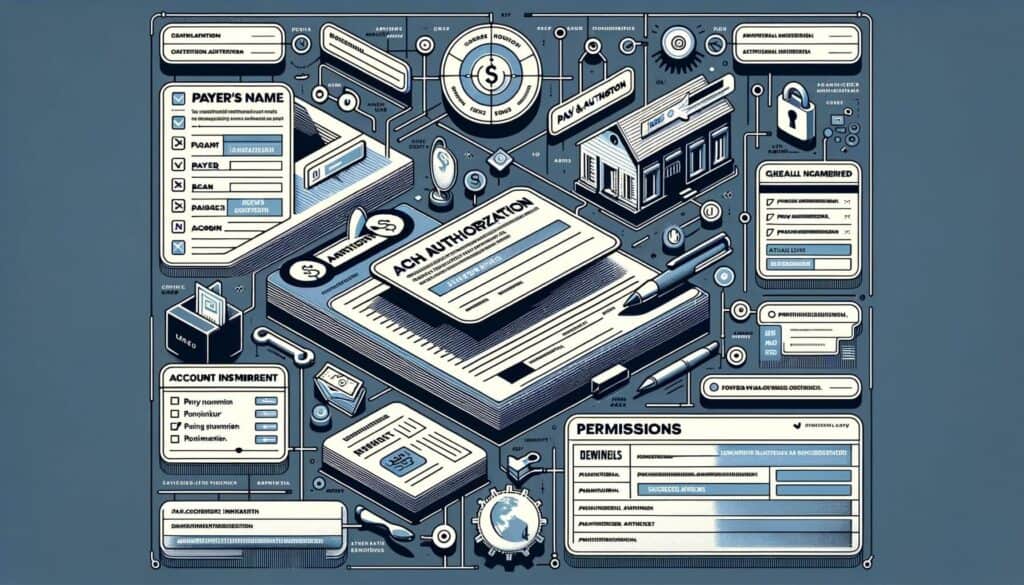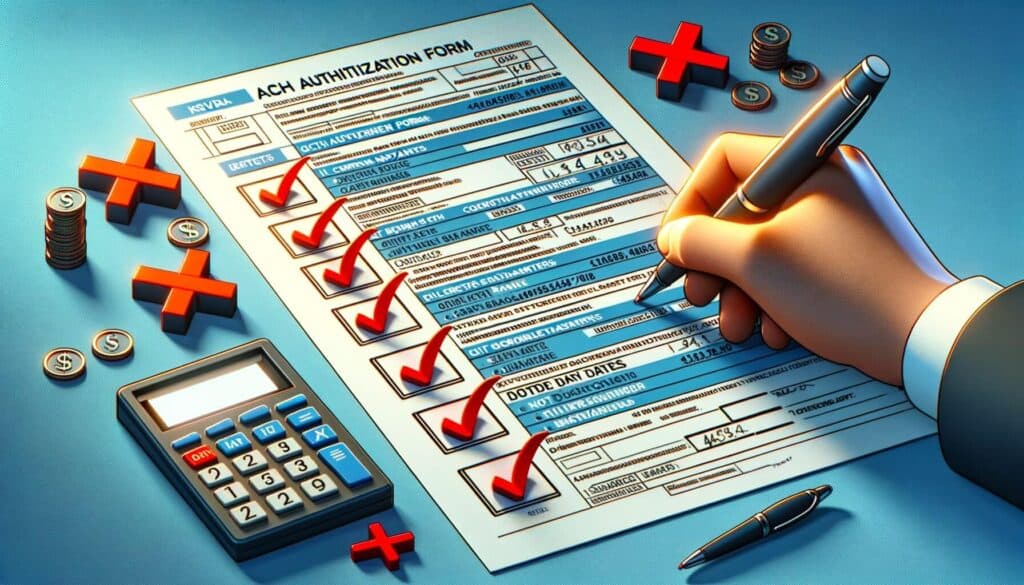
By Mollie Mills April 26, 2025
ACH (Automated Clearing House) authorization forms play a crucial role in facilitating electronic fund transfers. These forms serve as a legal agreement between a customer and a financial institution, authorizing the institution to initiate electronic transactions on the customer’s behalf.
In this comprehensive guide, we will delve into the purpose and importance of ACH authorization forms, provide a step-by-step guide on how to fill them out, explain the key components of these forms, highlight common mistakes to avoid, discuss security measures, explore how they facilitate electronic fund transfers, provide an overview of the processing of ACH authorization forms, and address frequently asked questions.
Understanding the Purpose and Importance of ACH Authorization Forms

ACH authorization forms are essential for enabling businesses and individuals to make electronic payments and transfers. These forms allow financial institutions to withdraw funds from a customer’s account and deposit them into another account electronically. The purpose of these forms is to provide a legal framework that protects both the customer and the financial institution, ensuring that transactions are authorized and executed accurately.
The importance of ACH authorization forms lies in their ability to streamline payment processes, reduce the reliance on paper checks, and enhance the efficiency of financial transactions. By authorizing electronic transfers, customers can enjoy the convenience of automated payments, while businesses can benefit from faster and more secure transactions.
How to Fill Out an ACH Authorization Form: Step-by-Step Guide

Filling out an ACH authorization form may seem daunting at first, but with a step-by-step guide, the process becomes straightforward. Here is a comprehensive guide on how to fill out an ACH authorization form:
Step 1: Obtain the ACH authorization form from your financial institution or download it from their website.
Step 2: Read the instructions carefully to understand the purpose and requirements of the form.
Step 3: Provide your personal information, including your name, address, and contact details.
Step 4: Enter your bank account information, including the account number and routing number.
Step 5: Specify the type of transaction you are authorizing, such as a one-time payment or recurring payments.
Step 6: Indicate the amount or percentage of funds to be transferred and the frequency of the transfers.
Step 7: Sign and date the form to validate your authorization.
Step 8: Review the completed form for accuracy and completeness.
Step 9: Submit the form to your financial institution, either in person or through their designated channels.
Step 10: Keep a copy of the form for your records.
Key Components of an ACH Authorization Form Explained

ACH authorization forms consist of several key components that are essential for ensuring accurate and authorized electronic fund transfers. Understanding these components is crucial for both customers and financial institutions. Let’s explore the key components of an ACH authorization form:
1. Personal Information: This section requires the customer to provide their name, address, contact details, and any other relevant personal information.
2. Bank Account Information: Here, the customer must enter their bank account details, including the account number and routing number. This information is necessary for initiating the electronic transfers.
3. Transaction Details: This section allows the customer to specify the type of transaction they are authorizing, such as one-time payments or recurring payments. They can also indicate the amount or percentage of funds to be transferred and the frequency of the transfers.
4. Authorization Statement: The authorization statement is a legally binding agreement between the customer and the financial institution. It outlines the customer’s consent to initiate electronic transfers and acknowledges their responsibility for any fees or charges associated with the transactions.
5. Signature and Date: The customer must sign and date the form to validate their authorization. This signature serves as proof of their consent and agreement to the terms outlined in the form.
Common Mistakes to Avoid When Completing an ACH Authorization Form

While filling out an ACH authorization form, it is crucial to avoid common mistakes that can lead to delays or errors in electronic fund transfers. By being aware of these mistakes, customers can ensure a smooth and efficient payment process. Here are some common mistakes to avoid when completing an ACH authorization form:
1. Inaccurate Personal Information: Providing incorrect personal information can lead to complications in processing the form. It is essential to double-check the accuracy of your name, address, and contact details before submitting the form.
2. Incorrect Bank Account Information: One of the most critical components of an ACH authorization form is the bank account information. Providing incorrect account numbers or routing numbers can result in failed or delayed transactions. It is crucial to verify this information with your financial institution to ensure accuracy.
3. Missing or Incomplete Transaction Details: Failing to provide complete and accurate transaction details can lead to confusion and errors in processing the form. It is important to specify the type of transaction, the amount or percentage of funds to be transferred, and the frequency of the transfers.
4. Failure to Sign and Date the Form: For the form to be valid, it must be signed and dated by the customer. Neglecting to do so can render the form invalid and delay the processing of electronic transfers.
5. Not Reviewing the Form for Accuracy: Before submitting the form, it is crucial to review it carefully for any errors or omissions. Taking the time to review the form can help identify and rectify any mistakes, ensuring a smooth payment process.
A Closer Look at ACH Authorization Form Security Measures
Security is of utmost importance when it comes to ACH authorization forms. Financial institutions have implemented various security measures to protect customer information and ensure the integrity of electronic fund transfers. Let’s take a closer look at some of the security measures associated with ACH authorization forms:
1. Encryption: Financial institutions use encryption technology to secure the transmission of ACH authorization forms and other sensitive information. Encryption ensures that data is encoded and can only be decoded by authorized parties, preventing unauthorized access or tampering.
2. Secure Data Storage: Financial institutions employ secure data storage practices to protect customer information. This includes measures such as firewalls, intrusion detection systems, and access controls to safeguard data from unauthorized access or breaches.
3. Two-Factor Authentication: To enhance security, financial institutions may require customers to provide additional authentication factors, such as a unique code sent to their mobile device, in addition to their username and password. This helps prevent unauthorized access to ACH authorization forms and other sensitive information.
4. Fraud Monitoring: Financial institutions employ sophisticated fraud monitoring systems to detect and prevent fraudulent activities related to ACH authorization forms. These systems analyze transaction patterns and identify any suspicious or unusual activity, triggering alerts for further investigation.
5. Compliance with Regulatory Standards: Financial institutions adhere to strict regulatory standards, such as the Payment Card Industry Data Security Standard (PCI DSS) and the Gramm-Leach-Bliley Act (GLBA), to ensure the security and privacy of customer information. Compliance with these standards helps protect against data breaches and unauthorized access.
How ACH Authorization Forms Facilitate Electronic Fund Transfers
ACH authorization forms play a vital role in facilitating electronic fund transfers by providing a legal framework for authorizing and executing transactions. These forms enable financial institutions to initiate electronic transfers on behalf of customers, streamlining payment processes and reducing reliance on paper checks. Let’s explore how ACH authorization forms facilitate electronic fund transfers:
1. Authorization and Consent: ACH authorization forms serve as a legal agreement between the customer and the financial institution, providing the necessary authorization and consent for electronic fund transfers. By signing the form, the customer acknowledges their responsibility for the transactions and authorizes the financial institution to initiate them.
2. Streamlined Payment Processes: ACH authorization forms eliminate the need for paper checks and manual payment processes. By authorizing electronic transfers, customers can enjoy the convenience of automated payments, reducing the time and effort required for traditional payment methods.
3. Faster and More Efficient Transactions: Electronic fund transfers initiated through ACH authorization forms are typically faster and more efficient than traditional payment methods. Once authorized, funds can be transferred electronically, reducing the processing time and enabling quicker access to funds for the recipient.
4. Cost Savings: ACH authorization forms can result in cost savings for both customers and businesses. By eliminating the need for paper checks and manual processing, businesses can reduce administrative costs. Customers can also save on postage fees and other expenses associated with traditional payment methods.
5. Enhanced Security: ACH authorization forms provide a secure method for initiating electronic fund transfers. Financial institutions employ various security measures, such as encryption and two-factor authentication, to protect customer information and ensure the integrity of transactions.
A Comprehensive Overview of ACH Authorization Form Processing
The processing of ACH authorization forms involves several steps to ensure accurate and timely electronic fund transfers. Financial institutions follow a systematic process to validate the authorization, verify the information provided, and initiate the transfers. Let’s take a comprehensive look at the processing of ACH authorization forms:
1. Receipt and Validation: Upon receiving an ACH authorization form, the financial institution validates the form to ensure it is complete and accurate. They verify the customer’s personal information, bank account details, and transaction details.
2. Authorization Verification: The financial institution verifies the customer’s authorization by cross-referencing the information provided on the form with their records. They ensure that the customer has provided the necessary consent and authorization for the electronic fund transfers.
3. Bank Account Verification: To initiate electronic transfers, the financial institution verifies the customer’s bank account information, including the account number and routing number. This verification ensures that the funds are transferred to the correct account.
4. Transaction Processing: Once the authorization and bank account information are verified, the financial institution processes the electronic fund transfers. They initiate the transfers according to the specified frequency and amount, ensuring accurate and timely transactions.
5. Confirmation and Notification: After processing the electronic fund transfers, the financial institution provides confirmation to the customer. This confirmation may be in the form of a transaction receipt, an email notification, or a notification through the customer’s online banking portal.
6. Reconciliation and Reporting: Financial institutions reconcile the transactions initiated through ACH authorization forms to ensure accuracy and completeness. They generate reports to track and monitor the transactions, enabling efficient record-keeping and auditing processes.
Frequently Asked Questions about ACH Authorization Forms
Q1. What is an ACH authorization form?
Answer: An ACH authorization form is a legal agreement between a customer and a financial institution, authorizing the institution to initiate electronic fund transfers on the customer’s behalf.
Q2. How do I obtain an ACH authorization form?
Answer: You can obtain an ACH authorization form from your financial institution or download it from their website. Some businesses may also provide these forms for recurring payments.
Q3. What information is required on an ACH authorization form?
Answer: An ACH authorization form typically requires personal information, including your name, address, and contact details. It also requires your bank account information, such as the account number and routing number.
Q4. Can I authorize one-time payments and recurring payments on the same form?
Answer: Yes, many ACH authorization forms allow you to specify both one-time payments and recurring payments on the same form. You can indicate the frequency and amount for each type of payment.
Q5. How long does it take for an ACH authorization form to be processed?
Answer: The processing time for ACH authorization forms may vary depending on the financial institution. In general, it can take a few business days for the form to be validated and the electronic fund transfers to be initiated.
Q6. Are ACH authorization forms secure?
Answer: Yes, financial institutions employ various security measures, such as encryption and two-factor authentication, to ensure the security of ACH authorization forms and protect customer information.
Q7. Can I cancel or modify an ACH authorization form?
Answer: Yes, you can cancel or modify an ACH authorization form by contacting your financial institution. It is important to notify them in advance to ensure that the changes are implemented before the next scheduled transfer.
Conclusion
ACH authorization forms are a vital component of electronic fund transfers, enabling businesses and individuals to streamline payment processes and enhance the efficiency of financial transactions. By understanding the purpose and importance of these forms, knowing how to fill them out correctly, and being aware of common mistakes to avoid, customers can ensure smooth and accurate electronic fund transfers.
Financial institutions play a crucial role in processing ACH authorization forms, implementing security measures to protect customer information and facilitate secure transactions. By following the step-by-step guide provided in this comprehensive article, individuals and businesses can navigate the process of ACH authorization forms with confidence and enjoy the benefits of electronic payments.